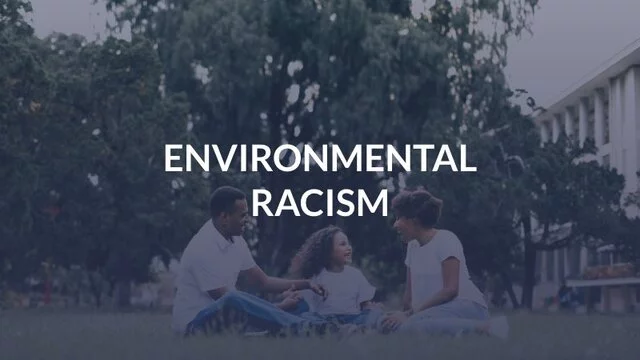
Environmental racism highlights systemic issues in how environmental policies are designed and enforced. It refers to the unequal exposure of communities to environmental hazards based on race or socioeconomic status. This pattern often stems from decisions about zoning, industrial development, and resource allocation that disproportionately affect marginalized communities.
What Is Environmental Racism?
Dr. Benjamin F. Chavis Jr. coined the term “environmental racism” to describe the intentional placement of polluting industries and hazardous facilities in communities primarily populated by African Americans, Latinos, Indigenous people, and other marginalized groups. These decisions often result in long-term exposure to harmful pollutants, leading to adverse health outcomes such as respiratory illnesses and cancer.
Research has shown that certain populations bear a greater environmental burden and face higher exposure to pollutants and hazardous conditions. This disparity is no coincidence, rather it is the result of systemic factors in policy making, enforcement, and land-use decisions. Some examples of this can be seen in:
Zoning
Zoning laws often concentrate on industrial facilities, highways, and waste management sites in low-income areas or neighborhoods. These decisions are typically justified as being economically efficient. However, the impact of the placement of these facilities and infrastructure disproportionately places environmental hazards near vulnerable populations, which often leads to significant health and safety concerns.
Enforcement of Environmental Regulations
Often, the enforcement of environmental regulations is significantly less strict in marginalized areas. Polluting industries in these communities tend to be inspected less frequently, and penalized less severely for violations, while industries in more affluent neighborhoods are more strictly held to higher standards.
Land-Use Decisions
Affected communities historically have lacked the political power, influence, resources, and representation that is necessary to challenge land-use decisions that are detrimental to their health. As a result, their voices are often excluded from discussions about decisions that will directly affect their health, quality of life, and well-being, thus perpetuating the cycles of environmental harm in areas that are already overburdened.
How Environmental Racism Impacts Human Rights
Human rights include the right to life, health, clean water, and a safe environment. When communities are disproportionately exposed to pollutants or lack access to basic environmental protections, these rights are often compromised.
Environmental racism can affect these communities in profound ways:
- Economically – the decline in property values caused by health risks and poor living conditions makes it harder for residents to build and pass down wealth to the next generations
- Health – increased exposure to toxic substances leading to higher rates of illnesses
- Quality of life – persistent environmental hazards can make these areas unsafe and undesirable to live in
- Political power – marginalized communities often lack the resources or representation needed to challenge these injustices
Several well-documented cases illustrate how environmental racism has affected various marginalized communities in the US:
- Jackson Water Crisis, Mississippi – years of neglect and underfunding, made worse by the state withholding federal funds for infrastructure improvements, left Jackson’s predominantly Black population with an unstable water system. The crisis hit a breaking point in August 2022 when severe flooding overwhelmed the city’s main water treatment plant, leading to widespread water shortages, prolonged health risks, and daily hardships.
- Cancer Alley, Louisiana – an industrial corridor along the Mississippi River between Baton Rouge and New Orleans is home to numerous chemical plants and refineries. The predominantly Black communities here experience significantly higher rates of cancer.
- Asthma Alley, the Bronx – the low-income communities in this part of New York City face some of the highest rates of asthma in the country. Factors that contribute to this include the close proximity to highways, waste transfer stations, and industrial sites.
- Flint Water Crisis, Michigan – the decision to switch Flint’s water supply source to the Flint River exposed the city’s predominantly Black population to lead-contaminated water.
- Standing Rock Sioux Tribe, North Dakota – the Dakota Access Pipeline was rerouted from crossing predominantly white areas to cross Indigenous lands. This raised concerns about water contamination risks and violations of tribal sovereignty.
This isn’t a coincidence, systemic factors in policy-making, enforcement, and land use contribute to the negative impacts these communities face. While laws like the Clean Air Act and Clean Water Act are designed to limit environmental harm, gaps in enforcement and systemic inequities leave these vulnerable populations unprotected.
Fighting for Environmental Justice and Accountability
Environmental racism is not just a failure of policy – it’s a human rights violation that continues to harm marginalized communities. From poisoned water supplies to unchecked industrial pollution, these injustices persist because systemic inequities allow them to.
At Singleton Schreiber, we believe that all communities deserve clean air, safe water, and protection from environmental harm. If environmental hazards have impacted you or your community, our environmental litigation team is here to help. We have the experience, resources, and dedication to fight to hold the responsible parties accountable to get you the justice you deserve. Contact Singleton Schreiber today to learn more about your options.
- Managing Partner, Southeastern Region
Letitia S. Johnson is the managing partner of our Southeastern Region offices and a leader in our Civil Rights, Environmental Litigation, and Wildfire Litigation practice groups. An accomplished attorney with deep ties and a ...

